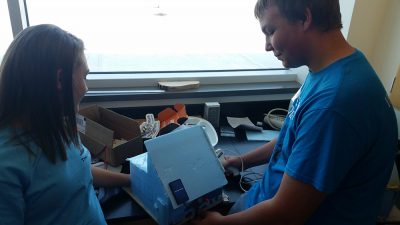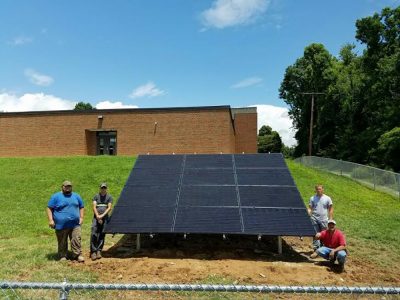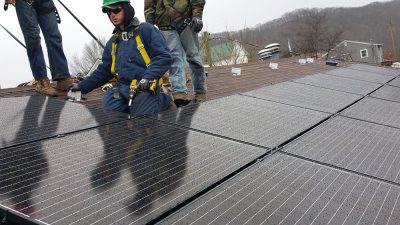Seeking Opportunities in Solar Energy
Solar energy is on the rise across the nation. According to The Solar Foundation, a nonprofit organization dedicated to advancing solar energy, “one out of every 50 new jobs added in the United States in 2016 was created by the solar industry.” Restrictive policies and lower population density, however, have led to solar power being less prevalent in rural mountain communities. But as the sun rises in Appalachia each morning, several groups are working to make sure it’s not just the mountains soaking up the sun’s rays.
Harnessing Solar in Appalachia
- Intro: Harnessing Solar
- Seeking Opportunities in Solar
- Rules of the Solar Game: Policies can create a level playing field or stack the deck
- Former Coal Company Town Integrates Energy Efficiency and Solar
- College Solar Vehicle Teams Drive Sustainable Transport Forward in Region
- Unique Solar Applications
Founded in 2016 and co-convened by the University of Virginia at Wise Office of Economic Development and Engagement, People, Inc., and Appalachian Voices, the publisher of this newspaper, the Solar Workgroup of Southwest Virginia aims to blaze a trail for renewable energy in seven historically coal-producing counties in Southwest Virginia.
The workgroup collaborated with communities in each county to create a detailed solar roadmap that identifies 15 potential sites for initial installations that would serve as solar “ambassadors.” It also proposes working with community colleges to educate future solar technicians and shows how new, solar-friendly state policies could help Virginia employ the region’s existing energy workforce to create hundreds of local jobs over the next 10 years.
One of the sites identified is Ridgeview High School in Dickenson County. The school, which already has a full-size wind turbine, could save $1.7 million in energy bills over 25 years with a 350-kilowatt solar array.
The Solar Workgroup recently won a $10,000 Department of Energy Sunshot Initiative grant to plan a path for solar development, and Ridgeview High School will be one of the sites developed as a result. Now, the school is in the running to win a larger Sunshot grant of up to $500,000 — which could fund the down-payment on a loan for the project.
According to Denechia Edwards, the supervisor of special education, career and technical education for Dickenson County Schools, the primary focus of installing the array would be the cost savings, with the added benefit of having the panels as an instructional tool in the sustainable and renewable technology course taught by Chris Owens.
Owens, who paid his way through college by working in the same coal mine as his father, wants his students to be able to take full advantage of the job opportunities in renewable energy. While he hates to see coal jobs go, he says they’re “just not the future.”
“As a teacher, I try to give [my students] as much opportunity as I can to find something that they’re going to be passionate about, find something that they’re going to want to do,” Owens says. “I like for kids to think of these type of classes as an opportunity to explore something that maybe they hadn’t thought of doing before.”

Ridgeview High students install solar panels on a model home. Photo by Chris Owens
Owens’ students have already designed an automated irrigation system for the school’s greenhouse and are able to learn hands-on from the wind turbine. Additionally, after Owens’ robotics team at Ridgeview was awarded a $500 mini-grant at the solar fair hosted by the Solar Workgroup of Southwest Virginia, his students were able to build solar panels for the creations made in his robotics class.
“I think it’s important for the kids to know that there’s a lot more out there for them to do than just definitions and bookwork all day long,” Owens says.
Denechia Edwards says that Appalachia is often overlooked when it comes to clean energy.
“We have so much land that is appropriate for renewable energy,” Edwards says. “Mountains, reclaimed coal mining land — there are opportunities here. We no longer can rely on coal in this area, and I think renewable energy is going to be one of those areas that’s only going to continue to expand. And if we can give our students a leg up, that would be awesome.”
Energizing Communities
According to Lydia Graves, the Southwest Solar Virginia VISTA for Appalachian Voices and a co-convener of the Solar Workgroup of Southwest Virginia, the most accessible solar option in the current policy climate is a residential system. While installing solar panels on a home may present a cost barrier, group-buying initiatives like the Solar Workgroup’s Solarize Wise program can help lighten the load.

Rewire Appalachia crew members stand next to a completed installation at the Ben Franklin Career Center in Dunbar, W.Va.
The U.S. Department of Energy helped start the first Solarize program in 2009 in Portland, Ore. Since then, Solarize programs have spread across the country — according to the DOE, by 2015 there had already been over 230 Solarize campaigns in 25 states and the District of Columbia.
“We’ve heard from people that they were interested in solarizing their home, but they didn’t know of any businesses serving the area before we launched Solarize Wise,” said Graves in a Sept. 13 press release. “Other people who have looked into solar in the past but couldn’t afford it are now revisiting the idea because the price has dropped so dramatically, and it makes financial sense for them.”
Around 50 people signed up for a free assessment of their property to see if solar would be right for them, and roughly 200 residents asked to receive more information. At press time, which was close to the Solarize deadline of Sept. 29, it was unknown how many residents had signed contracts with Sigora Solar, the installer selected by Solarize Wise.
Similar to Solarize programs are solar co-ops like Solar United Neighbors of West Virginia, only with co-ops, community members select an installer during the competitive bidding process.
The mountain state co-op is part of a network of solar cooperatives called Solar United Neighbors that works to educate communities about solar power and guide residents through the process of installing solar panels on their property.
“The co-op is effectively a bulk-purchase program, or a consumer co-op,” says Autumn Long, program director of Solar United Neighbors of West Virginia. “It’s a group of neighbors in a specific town or area who all go solar together.”
“Solar is the future of energy, and West Virginia has always been an energy-producing state,” she continues. “As the way energy gets produced shifts from fossil fuels to renewables, I want to make sure that my home state of West Virginia doesn’t get left out and continues to be able to be a part of that industry.”
While the price of solar panels has fallen steadily over the past few years, Long says that many people still tend to be under the impression that solar is unaffordable.
“The cost has come down so much that solar is really a good financial investment for a homeowner or small business owner,” Long says. “You will get a really good return on investment and save a lot of money over the course of your solar array.”
Utilities like Dominion Energy in Virginia are seeing the cost-saving benefits of solar too. After Dominion stated in a February press release that they plan to invest $800 million in solar in Virginia, it granted $150,000 to Virginia community colleges in March to hasten solar workforce development.
Lydia Graves says that as more people have access to solar, it builds familiarity in the community and people see it as a sound economic choice.
“They can see it as something feasible for the area, and not just something that’s in California and Arizona and Utah,” Graves says. “That would build a more renewable-friendly climate in Southwest Virginia.”
By going directly to a solar installer with a group of educated buyers, solar co-ops and Solarize groups are able to get the panels wholesale, usually with anywhere from a 20 to 30 percent discount.
And even though not everyone who expresses interest in the program ends up signing a contract with the installer to buy solar panels, Solar United Neighbors of Virginia Program Director Aaron Sutch says that co-ops also create a nonpartisan, educated constituency that will write their state representatives in support of fair solar policy.
“We’re not an environmental organization, per se — although everyone who works here is [an environmentalist],” Sutch says. “It’s really interesting because you have these co-op info sessions, and you get folks that are sitting next to each other talking about solar that you know did not vote the same way in the election and probably would have a spat on Facebook.”
Sutch sees the potential for an energy renaissance in the region.
“I think [solar power] is such an appropriate fit for Appalachia because there’s this ethos of self-sufficiency, of using local resources, people working with their hands,” Sutch says. “And renewable energy, specifically solar, is all of those things. … Think of the success of the local food and the farmers’ market movements. Renewable energy has the same potential to do that. It’s local energy that benefits local people.”
A Bright Jobs Future

Rewire Appalachia crew members install panels at Coalfield Development Corporation’s main office in Wayne, W.Va.
Photo courtesy of Asheville Solar Co. and Rewire Appalachia
A January 2017 Department of Energy report shows 373,807 people employed by the solar industry nationwide, compared to roughly 1.1 million in the coal, oil and natural gas industries combined. The United States coal industry employs 160,119 people — less than half of those employed by the nation’s solar industry.
Seeing an energy economy in transition, Tre’ Sexton, owner of Bluegrass Solar in Whitesburg, Ky., says he wants to help put as many miners back to work as he can.
“We really have an emphasis on trying to soften the blow in Appalachia over to the renewables — we think it’d be more of a welcome change if it comes from our own initiative,” Sexton says. “We don’t have many employees, but of those that we do have, we try to hire as many out-of-work miners and people in the coal industry and truck drivers as we can.”
Sexton’s company made headlines nationwide when it installed a solar array on the roof of the Kentucky Coal Museum in Benham, Ky. (read our story on the coal museum here). He isn’t alone in his efforts to revitalize Appalachia’s energy economy.
Adam Warren is president of solar installation enterprise Rewire Appalachia and construction enterprise Revitalize Appalachia, two of the seven social enterprises run by workforce development organization Coalfield Development Corporation. The organization describes a social enterprise on their website as “a business that combines the compassion of the nonprofit sector with the efficiency of the for-profit sector.”
Warren says the same skill set that led to Appalachia leading the country in energy production for the last hundred years can transfer to different forms of energy.
“All of our enterprises start with ‘Re.’ That’s because we’re not trying to start something new, we’re redoing something that was already here,” Warren says. “We’re just retraining the people in this area to see that they have skills that translate elsewhere. And so it brings back some of that hope and gets rid of the hopelessness in the area and they see that there is a future here — you just have to make it for yourself.”
All of the crew members employed by Rewire Appalachia and the other social enterprises at Coalfield Development follow what the organization calls a 33-6-3 workforce development model. It entails 33 hours per week of paid labor, six hours of courses at a local community college toward an applied science or technical studies degree paid through financial aid and Coalfield Development, and three hours of life skills training like money management. After Coalfield Development graduates complete the roughly two-year program, they have both experience in the field and an associate’s degree.
“There’s so many talented people in the area, but those people have only done one industry for so many years,” Warren says. “Appalachians have always been good at building things and making stuff. So why not take those skills and turn them into a potentially good entrepreneurial opportunity and create other small businesses or subcontractors?”
At Mountain Empire Community College in Big Stone Gap, Va., students can take a class on solar power as part of an associate’s degree in energy technology. In 2015, students developed the SPARC-E trailer, which stands for Solar Powered Alternative Renewable Clean Energy. Dean of Applied Science and Technology Tommy Clements describes it as a mobile showcase that produces power for events while educating people about solar power and how energy efficiency upgrades to their home can save on electric bills.
In the Sept. 13 Solarize Wise press release, Mountain Empire instructor Roger Greene said he hopes “as solar power [becomes] a viable option for employment in our area, we will already have an educated workforce capable of filling the need for professional installers. On the front end, I see projects like SPARC-E and Solarize Wise as the needed impetus for providing the public with access and a more clear understanding of solar power.”
According to Autumn Long with Solar United Neighbors of West Virginia, many of the abandoned strip mines and former industrial sites in West Virginia have the potential to become commercial-scale solar farms. Appalachia, she says, is “just seeing the very beginning of this exciting and significant shift in how energy gets produced and consumed.”
“I think my colleagues and other organizations and solar installers here in Appalachia are really forward-thinking and working really hard to develop the renewable energy industry in Appalachia,” Long says. “And there’s so much room for growth and so much potential for that, we really have nowhere to go but up.”
CORRECTION: Oct. 25, 2017
An earlier version of this article incorrectly stated that a January 2017 U.S. Department of Energy report shows that the solar industry employs 383,807 people compared to 187,117 in the coal, oil and natural gas industries combined. Those numbers apply only to electric power generation and don’t include the fuels sector. When combined, these fossil fuel industries employ 1,073,872 people as a whole, according to the DOE report.
Editor’s Note: This article was updated on Oct. 11 to reflect the name changes of solar co-op groups “Community Power Network” to “Solar United Neighbors,” “West Virginia Solar United Neighborhoods” to “Solar United Neighbors of West Virginia,” and “Virginia Solar United Neighborhoods” to “Solar United Neighbors of Virginia.”
Related Articles
Latest News

Leave a comment
Your email address will not be published. Required fields are marked *





Leave a Comment